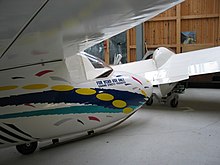Fauvel AV.36
| Fauvel AV.36 | |
|---|---|

|
|
| Type: | Glider |
| Design country: | |
| Manufacturer: |
Fauvel |
| First flight: |
December 31, 1951 |
| Production time: |
until 1959 |
| Number of pieces: |
over 100 |
The Fauvel Av.36 / AV.361 is a single-seat Brushless as a means Decker been deliberate Glider , which in the 1950s by Charles Fauvel was designed. The designation “AV” in AV.36 stands for “Aile Volante” (literally “flying wing”, meaning flying wing aircraft ). Because of the two vertical stabilizers, the AV.36 is not considered a true flying wing, although it generates flight stability and lift solely through the wing geometry. First flight was on December 31, 1951 in France.
Building description
The light, single-seater wooden construction with fabric covering consists of a teardrop-shaped short fuselage and an unarrowed rectangular trapezoidal wing with the S-flap profile Fauvel F2 17%. The wings are rigidly connected to the fuselage and cannot be removed. The elevator and rudder are part of the wing center section. In addition to the two ailerons, the wing has two airbrakes, which are only located on the underside of the wing outside of the side fins.
Compared to other known tailless aircraft, the AV.36 had extremely good flight characteristics. The longitudinal stability otherwise given in normal fuselage aircraft was ensured in the AV.36 by the special wing profile with raised trailing edge. For land transport on a trailer, the AV.36 is loaded lengthways and the two rudders folded on the wing, the transport width is then 2.38 meters.
For winch launch or aircraft towing , the AV.36 has two center of gravity couplings (so-called side wall couplings), which are attached to the left and right of the fuselage and are connected to the actual tow rope via a short V-rope (fork rope). The V-arrangement is necessary due to the lack of longitudinal stability in the initial phase of the towing process in order to prevent the machine from breaking out to the side.
It is easy to fly and was therefore often used as a training aircraft in aviation clubs. In addition, she proved herself in aerobatics. At flight days, the AV.36 is still a special attraction in the aerobatic program.
Motor gliders were also manufactured from the AV.36 , which were equipped with an engine between the vertical stabilizers and with a pusher propeller. In Germany, Bölkow GmbH built a single motorized model with the type designation AV.36 Cm, which was given a split elevator due to the propeller shaft. This modification was also given to the further developments AV.361 and AV.45 (motor glider) because of the longer and more aerodynamically designed fuselage nacelle. In the original version with a continuous elevator, after the introduction of a one-piece cabin glazing, the elevator sometimes shook, which is why a so-called smoothing ring had to be attached behind the hood (see picture on the left).
The variant AV.361 had a wingspan of 13 m and also had some slightly modified vertical stabilizers, which were swept back a little and made a little more angular. This increased the glide ratio to 28. These vertical stabilizers were also used in the motor glider version AV.45 (see drawing on the right).
The last member of the aircraft family was the AV.451 with a 15 m span and a laminar profile Wortmann FX 66-H-159, which achieved a glide ratio of 32. In terms of performance, it was roughly in the range of comparable (rib construction, laminar profile, 15 m wingspan) to normal gliders such as the Schleicher Ka 6e or the disc SF 27 .
Up to 1997 over 150 copies were made in different countries, the exact number cannot be quantified. The construction plans for the AV.36 have hardly changed since Fauvel's death in 1979. A Canadian company still offers building plans and partial kits. The Luftfahrt-Bundesamt blocked all German registered AV.36s for flight operations on October 11, 2016 in response to an accident after the main spar was broken in flight.
Variants in Germany
- AV.36 C - glider from 1957
- AV.36 CR - glider from 1958
- AV.36 cm - motor glider, single copy D-KDAZ, later D-1753 that was dismantled to a glider
Technical specifications
| Parameter | Data ( D-6200 serial number: 222 ) |
|---|---|
| crew | 1 |
| length | 3.17 |
| span | 11.95 m |
| Wing area | 14.23 m² |
| Empty mass | 125 kg |
| Takeoff mass | 225 kg |
| Minimum speed | 55 km / h |
| Top speed | 205 km / h |
| Glide ratio | 24 at 82 km / h |
| use | Practice flights, aerobatics |
Web links
- Operating manual AV.36, approved by LBA May 1957
- Fauvel AV.36 in the Deutsches Museum in Munich
- AV.36 on transport trailer Photo: Hahnweide Air Day 2007
Individual evidence
- ^ Martin Simons: Segelflugzeuge - 1945 to 1965. Eqip Werbung & Verlag GmbH, 2006, pp. 61–64.
- ^ Ian Tunstall: Fauvel's Flying Wings. In: Airplane Monthly October 1997, p. 57.
- ↑ http://www2.lba.de/dokumente/lta/ad1004460.pdf
- ↑ Data sheet AV.36 ( Memento of the original from February 1, 2014 in the Internet Archive ) Info: The archive link was inserted automatically and has not yet been checked. Please check the original and archive link according to the instructions and then remove this notice.


